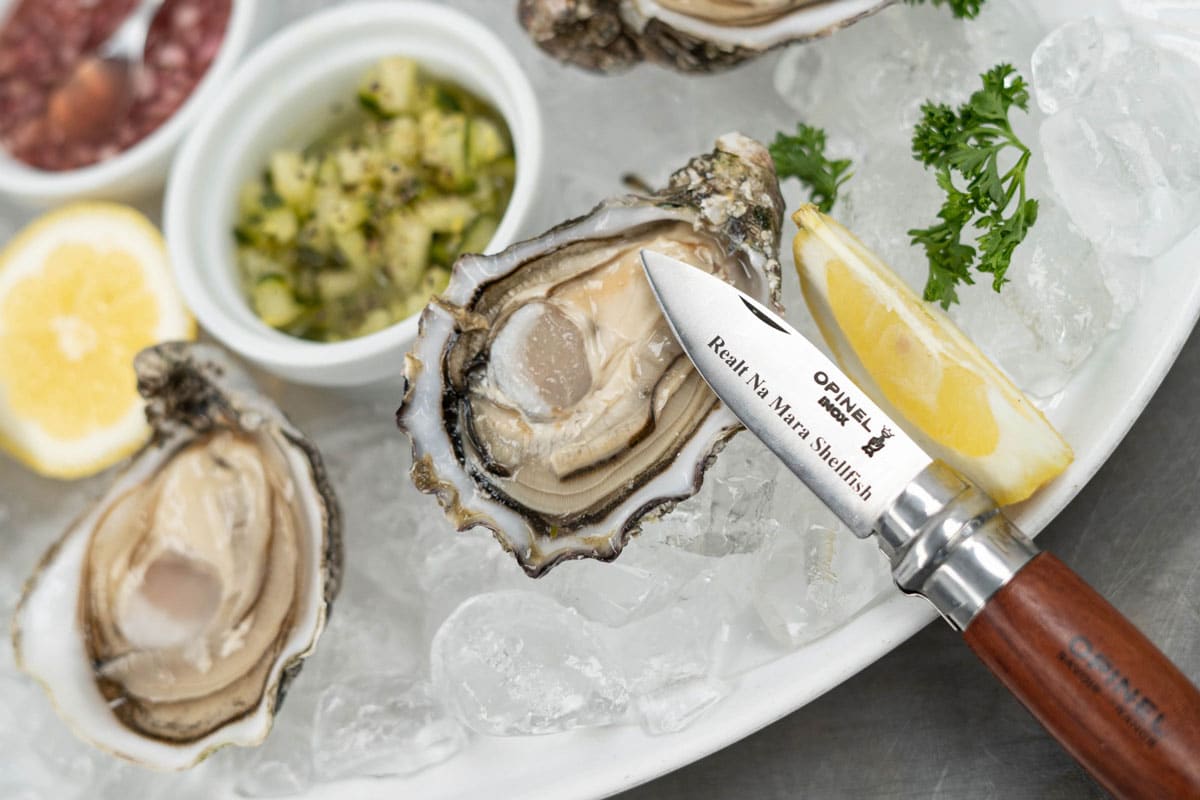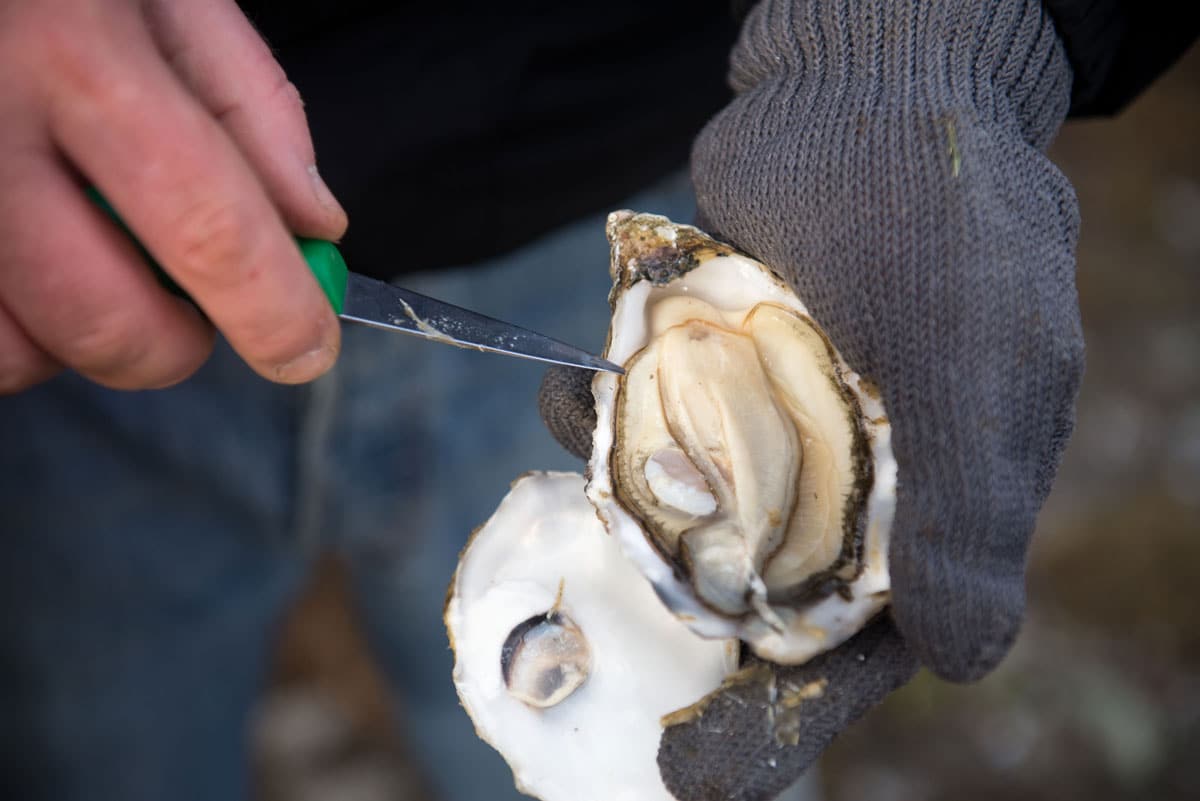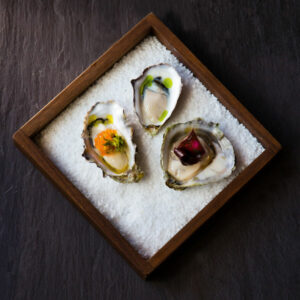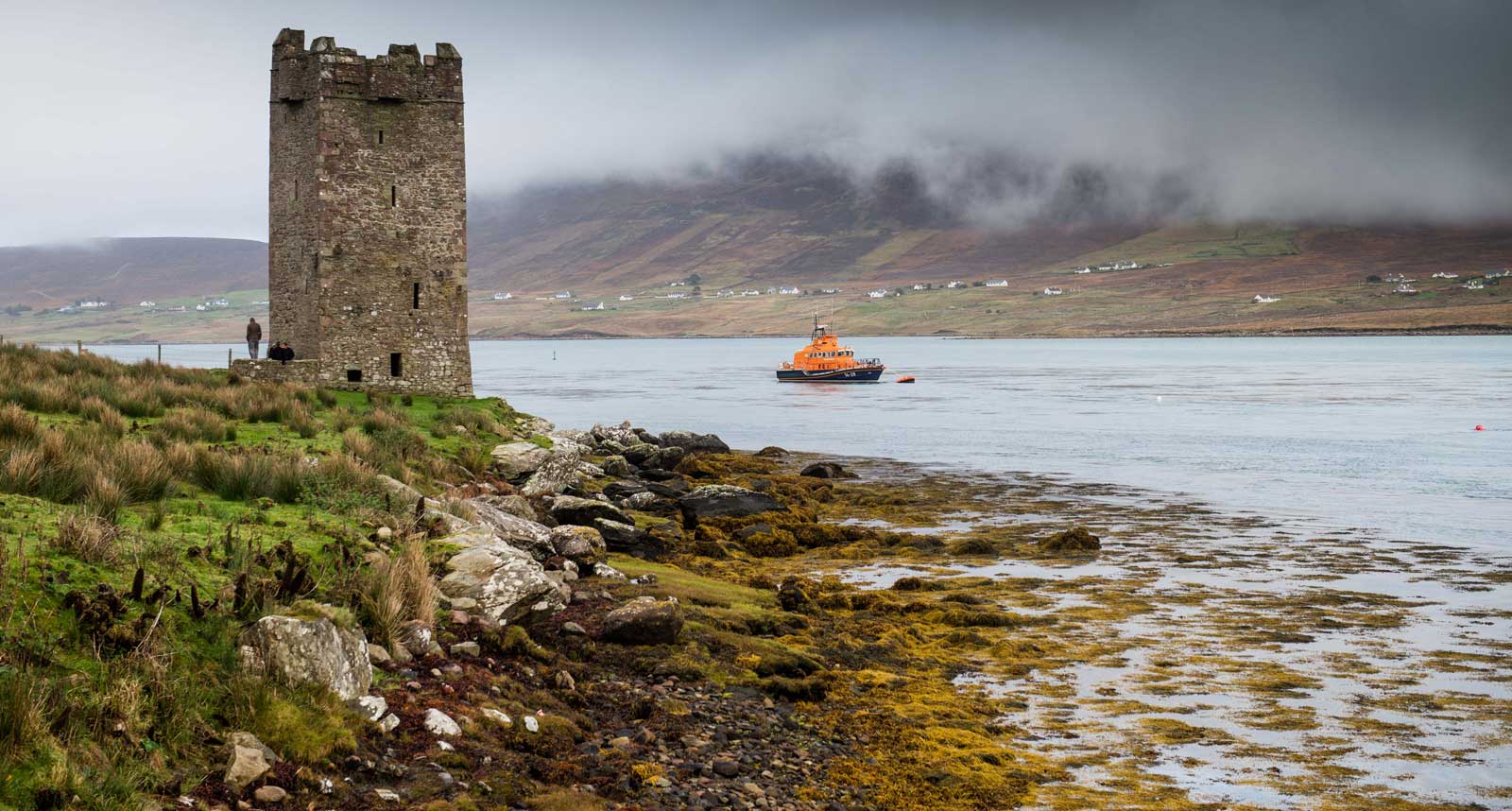
Every oyster tastes different, reflecting the unique landscape where it’s been farmed. John Wilson investigates the lofty shellfish’s ‘mer-oir’.
All Oysters Are Not The Same
 Oysters were once plentiful in Ireland. Apparently, our love of this mollusc goes back over four thousand years. In the 19th century, vast quantities of the native wild Ostrea edulis were harvested from naturally occurring beds in most of our bays and inlets and large beds running parallel to the East coast of Ireland. By the end of the century, overfishing and disease lead to the virtual extinction of native oysters.
Oysters were once plentiful in Ireland. Apparently, our love of this mollusc goes back over four thousand years. In the 19th century, vast quantities of the native wild Ostrea edulis were harvested from naturally occurring beds in most of our bays and inlets and large beds running parallel to the East coast of Ireland. By the end of the century, overfishing and disease lead to the virtual extinction of native oysters.
The first efforts at cultivation go back to the mid 18th century, but it was only in the 1970s that oyster farming took off with the introduction of the Pacific oyster, Magallana gigas. Unlike native oysters, the Pacific or Irish rock oysters could be eaten all year round, reached maturity quicker, and is resistant to disease. These days almost all the oysters we consume are Irish rock oysters, although a few producers also farm natives.
The first time I realised that all oysters were not the same was in a bistro in Bordeaux, where I was presented with a plate of eight oysters, each harvested from a different region of France. There were oysters from Brittany, Normandy, Arcachon, Etang de Thau, the Vendée and other parts of the country.
All shared that gorgeous briny tang and smooth succulent buttery flesh, yet each one had a distinctive flavour. Fast forward a few years, and the Cliff Townhouse on St. Stephen’s Green held a tasting with Irish oysters from four different regions of Ireland. Again, each was delicious yet had a subtly different flavour.
In the world of wine, this is called ‘terroir’, the way a wine reflects the soil and climate where its grapes are grown. As oysters aren’t grown in soil, it maybe makes some sense to call this mer-oir?
Chef JP McMahon of Aniar and Tartare in Galway admits that each oyster he’s ever eaten has its own specific taste depending on the producer, although this may also be because each producer farms in a different location. At the moment he serves oysters from three different producers in his Tartare; Their signature Dooncastle oyster with sea lettuce and Goatsbridge trout caviar, Kelly’s oyster with pickled wild rose vinegar and dillisk and Flaggy Shore oysters with Cuinneog buttermilk and chive oil. His new book “The Irish Fish Book” (set to be published in 2022) lists almost 50 different oyster recipes.
According to Joe Harty of Dungarvan Shellfish in Waterford, an oyster’s flavour changes according to the seasons. “In summer we have lots of seaweed in the bay, sea lettuce and sugar kelp. That makes them sweeter. In winter, they are saltier because there is no seaweed. Dungarvan oysters taste of cucumber and pistachio. The salinity is a lot lower here; we have three rivers bringing a lot of freshwater into the estuary. The larger oyster, 150-gram plus, is super; I love to barbecue them.”

Garry Hughes, the executive chef at The Shelbourne, favours Dungarvan oysters when serving raw oysters.
“These have a creamier, sweeter taste.”
For his signature Shelbourne oyster dish, he prefers the saltier Realt na Mara Shellfish.
Hugh O’Malley of Achill Oysters explains that his oysters have a very rich and creamy taste that comes from the peat bogs.
“We get an abundance of salinity when it doesn’t rain so they have a clean fresh marine taste, a real pop of the sea.”
In Kerry, Sharon Sugrue of Realt na Mara believes their unique location brings a different taste to the oyster.
“They are certainly different, briny yet smooth and full of meat.”
REALT NA MARA SHELLFISH, in Kerry
Realt na Mara, a family-owned company, was founded in 2015 but, Sharon Sugrue tells me, “We’ve been doing this since we could walk. Mussels were always the traditional thing here in Cromane. Our grandfather and fathers were always at it; they worked in a mussel factory here in the 1960s.”

Cromane lies within Castlemaine Harbour in Co. Kerry. “We have the wild Atlantic sea coming in from the west but we are sheltered, and then we have the water coming in from three rivers including the Laune from Killorgan and the Maine through Castlemaine.” The rivers add to the nutrients and quality of the water.
“We are lucky with the site,” Sharon continues, “It’s as close as you can get to organic. There is nothing added to our oysters. It’s really about husbandry; most of the work is done at low tides. That is when we do the shaking, trying to get a good deep shell with a tear-dropped shape. You have to mind them a little and know when to leave them alone. We didn’t touch them in the recent heat for instance,” she explains.
“I can tell just by looking at an oyster if they are ours. They are like my children.”
At Realt na Mara, they run a farm-to-fork operation. “I deliver locally and know all the chefs. We are relatively new to this end of the market so I love hearing back from them.” They also export to France and the Netherlands.
View our review of Realt na Mara
ACHILL OYSTERS, in Mayo
 Hugh O’Malley was brought up on Achill Island. “At 13, I moved to England. My dad had a trawler as did my grandfather and great grandfather; there was always fishing in our household. I always thought aquaculture could be a good alternative to fishing and I got the opportunity to do it.”
Hugh O’Malley was brought up on Achill Island. “At 13, I moved to England. My dad had a trawler as did my grandfather and great grandfather; there was always fishing in our household. I always thought aquaculture could be a good alternative to fishing and I got the opportunity to do it.”
Their oyster farm is fed with spate rivers, coming off the bogs. “At the end of the summer, the entire bay will turn a lovely peaty brown colour as it is swept out off the banks into the tributaries and then the river. It gives a unique taste and flavour; of course, I would say the best!” Hugh laughs. “We don’t have a lot of food in the water so our oysters take longer to grow, therefore have fuller meat. We are on the east coast of Achill, in a site chosen because it gets a wind coming across the island creating staccato waves 18 inches high and three feet apart that give the oysters a good bang. It is the equivalent of giving them a good shake.”
Hugh admits that the farm has been a great journey. “I spend time with my children and working with my dad. It’s a love affair. We’ve had challenges over the last eighteen months, but it is made easier because you are out in the open-air running your own business.”

And the best way to eat an oyster? “As God intended, naked, fresh from the sea, in your oilskins, knife in hand maybe with a dash of Tobasco.” However, he also recommends his wife’s go-to recipe – see below.
View our Review of Achill Oysters
Oyster Recipes

While most of us eat our oysters raw, accompanied by lemon juice or Tabasco, perhaps a twist of black pepper, or with a mignonette dressing, there are plenty of ways to cook them without losing that delicious briny flavour. Oyster Rockefeller is probably the best known, but below are three very different recipes.
Oysters Shelbourne
Served with Liscannor crab meat and lobster glazed with Hollandaise sauce and Gruyère cheese.
Ingredients:
- 6 Realt na Mara oysters
- 30g garlic butter
- 30g Liscannor crab meat
- 5g chopped chives
- 2g lemon juice
- 2g lemon zest
- 2g grain mustard
- 30g Lambay lobster meat, cooked then diced.
Thermidor sauce:
- 2 shallots, finely diced
- 50ml Jameson Black Barrel whiskey
- 200ml cream
- Lemon juice
- Dijon mustard, to taste
- Gruyère, to taste
For the Hollandaise sauce:
- 75g clarified butter
- 1 large free-range egg yolk
- 1 tbsp white wine vinegar reduction
- Lemon juice
For the Thermidor sauce:
Sweat the shallots in oil, add the whiskey, flambé to remove the alcohol, add cream and bring to a boil, add lemon juice, mustard and Gruyère to taste.
To make the Hollandaise, mix the egg yolks and vinegar together in a bowl, whisk over a pot of barely simmering water until the ribbon stage is achieved. Emulsify in the butter slowly until fully incorporated. Finish with lemon juice.
Shuck the oysters, pass the oyster juice through a fine sieve to remove any shell. Mix the crab with the lemon juice and zest. Finish with chopped chives.
Warm the oysters in garlic butter until just cooked, add lobster and crab meat and heat through. Add a little Thermidor sauce and heat through, do not boil.
Finish with a spoon of hollandaise sauce, add the shellfish mixture back into the oyster shells, place under a grill or in the oven until a little colour is achieved.
Oysters with Spinach and Cream
from Fiona O’Malley of Achill Oysters
Ingredients:
- 24 large Achill Oysters
- 500ml of cream
- One bag of spinach
- 2 cloves of garlic, chopped
- Salt, pepper and mixed herbs to taste
- Buttered crusty bread, to serve
Method:
Put the oysters cup-side down on a baking tray and pop them in the oven at 160C for 5-10 minutes. The heat will open them without you having to shuck them.
Bring the cream to a simmer in a small saucepan on the stovetop, add the spinach and season.
With an oven mitt and sharp knife remove the oyster’s top shell (flat side). Arrange the oysters back on the tray, keeping as much liquid in the shells as possible. Add your mixture from the saucepan into the shells and pop them back into the oven for another 15 minutes or until the cream begins to bubble.
Make sure you have enough bread to soak up all the goodness.
Cromane Rock Oyster, Seaweed & Green Olive, Bacùs Sliders, Yuzu Aioli
From Nicky Foley of Solas in Dingle
“This is a new addition to my menu. Realt na Mara Cromane Oysters are a meaty treat and work beautifully in a slider snack.”
Ingredients:
- 8 Realt na Mara Cromane Oysters
- 100g of flour (in a flat tray)
- 6 eggs whisked (in a bowl)
- 200g of Panko Bread Crumbs (in a bowl)
- 100g fresh seaweed (dillisk), finely chopped
- 200g green olives, chopped
- 25g ginger, finely chopped
For the relish:
- 100mls soy sauce
- 100mls mirin
- 75g sugar
- 50ml water
- 1 star anise
- 2 peppercorns
For the aioli:
- 5 tbsp yuzu juice
- ½ tbsp Dijon mustard
- 1 tbsp fine sea salt
- ½ tbsp sugar
- 1 tbsp miso paste
- 3 egg yolks
- 2 cups vegetable oil
Method:
Place all the relish ingredients into a pan and reduce them down by half. Pass through a fine sieve and chill.
To make the aioli, whisk together all the aoili ingredients in a bowl, apart from the vegetable oil. Then slowly add the oil, whisking all the time. Check the seasoning. Place the yuzu mayo into a piping bag and chill.
When the soy relish is cooled add the chopped seaweed, olives and ginger. This can be stored in the fridge for 10 days.
Shuck the oysters over a bowl of ice to keep them as cool as possible.
Take one oyster at a time and dip into the flour, then the egg and roll in the panko bread crumbs. Chill.
Turn on the deep fat fryer to 180 degrees.
Cut the Bacùs brioche bun in half and gently toast on the cut side
Place a good dollop of yuzu aoili on one side of the toasted bun.
Fry the oyster till golden brown, place on the bun, top with a spoon of relish, place the other bun on top and enjoy.
Explore & Book
Food & Drink Experiences
Luxury Overnight Stay and Afternoon Tea for Two at the Grand Central Hotel
What You’ll Get Luxury overnight accommodation for 2 in the Grand Central Hotel Belfast, including afternoon tea in the Observatory – ‘Irelands highest cocktail bar’ Stay in a Deluxe Bedroom with views over the city, and enjoy a full Irish...Wild Atlantic Distillery Tour & Tasting
What You’ll Get Witness the magic of distilling with a visit to Wild Atlantic Distillery located in the north-west of Ireland. Brian and Jim, your hosts will give you a warm welcome with a complimentary drink waiting at your arrival. Following this,...Wild Atlantic Distillery Cocktail Class
What You’ll Get You’ll be welcomed with a famous Wild Atlantic Irish Gin Bramble before being guided through the wonderful world of mixology with this fun and fantastic experience. You’ll learn how to make the perfect gin cocktail that...


